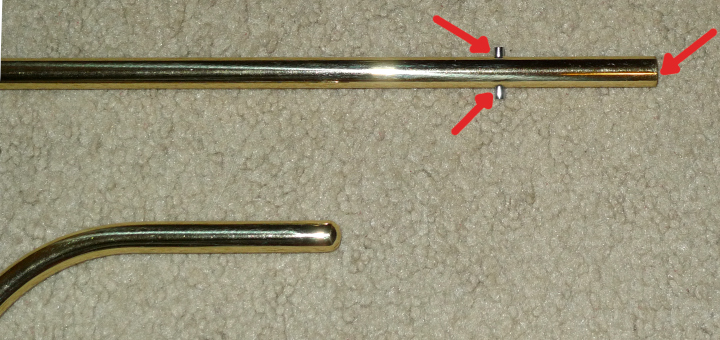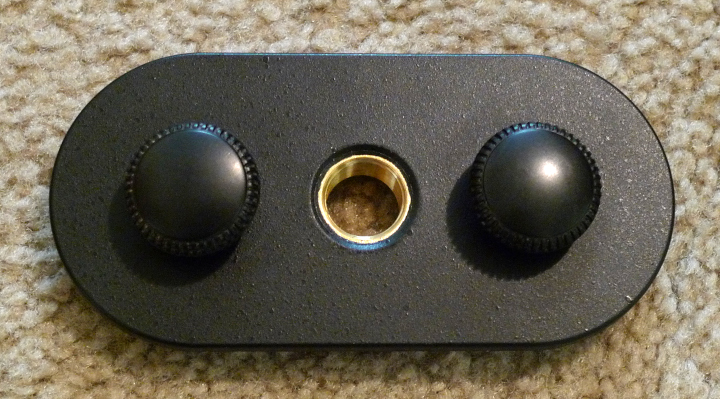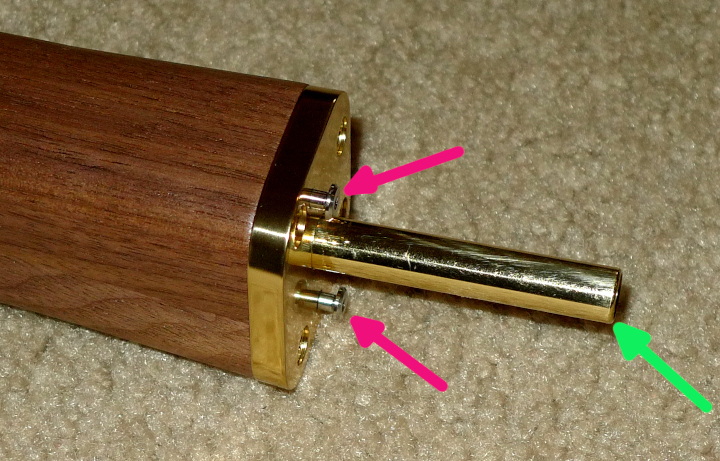Claravox Repair - Take 2
Jeff (ContraDude) came back by again today with his ailing serial #00218 Claravox. As seen in his video posted up-thread, he was able to get the volume side to work by slightly inserting the volume loop while holding it with his hand, and this was repeatable both at his place and mine. In this configuration, I measured 541.5kHz at the volume loop. A DMM showed good conductivity now at the end face, as well at the mounting studs, as Jeff had previously worked to remove the insulative clear coat at these locations (red arrows below). Full insertion of the now well connected volume loop resulted in no sound, and 538.7kHz:

With the loop still installed correctly, I inserted the small white screwdriver type end of the plastic hex tuning tool (provided with the Claravox by Moog) and tried small adjustments in both directions. Turning the coil slug clockwise increased the frequency, CCW decreased it, but these small adjustments didn't lead to the unit producing any sound.
I got out my old scope and hooked my DIY high voltage probe to it. Turning the coil slug CCW increased the antenna voltage, and I just kept turning it, maybe 2 full turns or more (!) until the voltage peaked at 60Vpp around 500kHz, and lo and behold we got sound! I switched the scope probe to a simple wire in the general vicinity of the volume loop and played with the "Volume Antenna" knob on the front panel. Fully CCW gave 510kHz, straight up 501.3kHz, and fully CW 492.5kHz, so this is a fairly linear oscillator frequency control. Adjusting the slug for maximum voltage with this knob set straight up seemed to give the best volume response knob adjustment range. Note that the volume out of the unit is directly proportional to the antenna voltage swing so: 1) if it's too low then you won't hear anything, and 2) the volume itself can be used as a tuning aid (see below).
We played around with it for another half an hour or so, trying the various modes, and exercising the antenna mount several times, and the Claravox seemed solid, but I guess time will tell.
It was actually Jeff's idea yesterday that Moog was probably using a different "stock" antenna at the factory to do the tuning. If the fix holds then insulating varnish was almost certainly the root problem here, with accompanying miles off factory tune job.
While the Claravox was here I took another look at the mounting bracket thing:

It looks like metal from this side, but it's actually all plastic (except for the embedded mounting nut and screw threads).
I also took a DMM to the pitch arm:

There was good conductivity around the end (green arrow) and the shoulder screws (pink arrows). The shoulder screws were loose by the way, probably to fit, but they could use some Locktite. If your pitch arm is droopy (making you unpopular with the ladies) you might check these for tightness.
[EDIT] So a proposed volume loop "tuning" procedure sans equipment:
0. Ensure volume loop connectivity (sand the end face and locking studs if necessary).
1. Put the Claravox in "Traditional" mode.
2. Set the "Volume Antenna" knob to 12 noon (straight up).
3. Adjust the volume coil slug for maximum volume with your hand away from the volume loop (kinda hard to do while adjusting the slug!).
4. Wiggle the "Volume Antenna" knob to ensure maximum volume is around 12 noon, if not repeat step 3 & 4 until it is.





